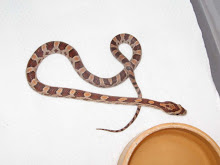


Corn Snakes are not highly active and do not need huge enclosures. A medium sized vivarium (Even a fish tank with a tight fitting lid) will house your Corn Snake nicely. The vivarium should allow a minimum of 1 square foot of floor space to each foot of snake and be approximately a third of the snake’s length in height. Hatchlings should start out in an appropriately sized small vivarium as they can become stressed and stop feeding in a Vivarium that’s too big.
Corn Snakes are excellent escape artists, so care must be taken when planning their housing. Make sure your vivarium or tank has a tight fitting lid, which can be clamped down. Corn snakes are very strong and can push a loose fitting lid from a vivarium.
Corn Snakes are relatively easy to care for, as they poo rarely, so with regular spot cleaning a full vivarium clean out should only be necessary every 3-5 weeks. When you clean out the housing, disinfect the cage furniture and the inside of the vivarium with a weak disinfectant solution or a reptile safe product. In general, if a disinfectant is safe to use for disinfecting baby bottles, then it is weak enough to use with snakes. Completely dry the contents before replacing in the vivarium with fresh substrate. For hygiene reasons it is advised to use seperate towels and cleaning cloths for your snakes.
Corn Snakes are excellent escape artists, so care must be taken when planning their housing. Make sure your vivarium or tank has a tight fitting lid, which can be clamped down. Corn snakes are very strong and can push a loose fitting lid from a vivarium.
Corn Snakes are relatively easy to care for, as they poo rarely, so with regular spot cleaning a full vivarium clean out should only be necessary every 3-5 weeks. When you clean out the housing, disinfect the cage furniture and the inside of the vivarium with a weak disinfectant solution or a reptile safe product. In general, if a disinfectant is safe to use for disinfecting baby bottles, then it is weak enough to use with snakes. Completely dry the contents before replacing in the vivarium with fresh substrate. For hygiene reasons it is advised to use seperate towels and cleaning cloths for your snakes.


